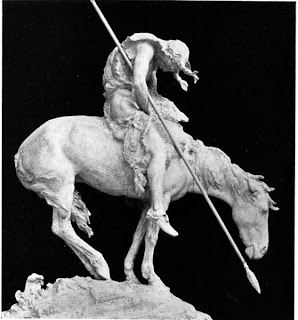WE WILL BE KNOWN FOREVER BY THE TRACKS WE LEAVE BEHIND

On May 27 at 9:00 PM, the epic drama Bury My Heart At Wounded Knee based on Dee Brown's non-fiction book will debut on HBO. Published in 1971, Dee Brown's book is one of the foremost works documenting the systematic subjugation of the American Indian during the latter half of the 19th century. It has sold nearly five million copies and has been translated into 17 languages. BURY MY HEART AT WOUNDED KNEE powerfully explores the tragic impact that the United States' westward expansion had on American Indian culture, and the economic, political and social pressures that motivated it.
The Wounded Knee Massacre was the last major armed conflict between the Dakota Sioux and the United States, subsequently described as a "massacre" by General Nelson A. Miles in a letter to the Commissioner of Indian Affairs.
On December 29, 1890, five hundred troops of the U.S. 7th Cavalry, supported by four Hotchkiss guns (a lightweight artillery piece capable of rapid fire), surrounded an encampment of Miniconjou Sioux (Lakota) and Hunkpapa Sioux (Lakota) with orders to escort them to the railroad for transport to Omaha, Nebraska. The commander of the 7th had been ordered to disarm the Lakota before proceeding and placed his men in too close proximity to the Lakota, alarming them. Shooting broke out near the end of the disarmament, and accounts differ regarding who fired first and why.
By the time it was over, 25 troopers and 300 Lakota Sioux lay dead, including men, women, and children. Many of the dead soldiers are believed to have been the victims of "friendly fire" as the shooting took place at point blank range in chaotic conditions, and most of the Lakota had previously been disarmed. Around 150 Lakota are believed to have fled the chaos, of which many likely died from exposure


7 comments:
There is so much of our history that causes me to hang my head in shame and despair of what people have done.
This is one of those times.
That is such a tragic story, that only happened in 1890?
I hope we get it over here eventually.
Did you see my blog friends post?
So many tragedies throughout our history. I'll see if I can catch this.
You know, teaching North Carolina History, the only thing I dont like about that book is the lack of information on the way the tribes in the East were wiped out first. Other than that it is a fine book.
Steve,
In a way that is the whole point of the book. This was the LAST of the massacres. After 1890 there were no Indian lands other than reservations and territories. It had all been taken away.
I had an uncle born in "Indian Territory" in 1901 by the time my second uncle came along in 1902 it was Oklahoma.
I read that book many years ago, and my hair stood on end throughout the read. I'm not sure I'd be able to withstand the movie without a crate of Kleenex.
I participate in the Manic Monday meme. My post this week talks about Black Indians. Check it out if you have time.
The whole incident at Wounded Knee is remarkable.
Post a Comment